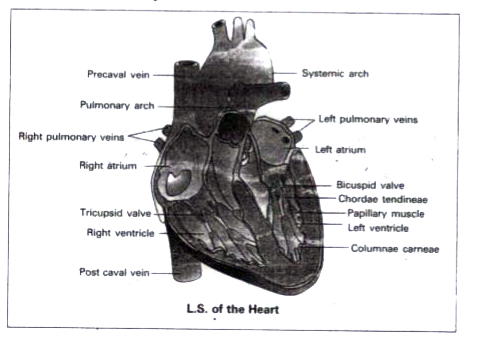Describe the structure of human lungs with the help of a diagram Solution in Telugu
Human heart is a hallow muscular, cone shaped, and pulsating organ situated between lungs. It is about the size of a closed fist.
The heart is covered by double walled lpericardium, which consists of outer fibrous pericadium and inner serous pericardium. The serous pericardium is double layered, outer parietal layer and inner visceral layer. These two layers are separated by pericardial space, which is filled with pericardial fluid. This fluid reduces friction between the two membranes and allow free movement of the heart.
Human heart has four chambers with two smaller upper chambers called atria and two larger low chambers called ventricles. Atria and ventricles are separated by a deep transverse groove called coronary sulcus.

i) Atria :
Atria are thin walled receiving chambers. The right one is larger than the left.
The two atria are separated by thin inter-atrial septum. It has a small pore known as Foramen Ovale in fetal stage. Later it is closed and appears as depression (oval patch) known as .Fossa ovale.. If the formen ovale does not close properly it is called a patent foramen ovale.
The right atrium recelves deoxygenated blood from different parts of the body, through three caval veins like two precaval veins and one post caval vein.
The right atrium also receives blood from wall of the heart through coronary sinus, whose opening into the right atrium is guarded by the valve of Thebestus.
Opening of the post caval vein is guarded by the Eustachian valve. It is functional in fetal stage and directs the blood from post caval into left atriuim through foramen ovale. But it is non-functional in adult.
The openings of the precaval veins into the right atrium have no valves.
Left atrium receives oxygenated blood from lungs through a pair of pulmonary veins, which open into the left atrium through a common pore.
Atrio-ventricular septum separates atria and ventricles. It has right and left atrio-venticular aperture.
Tricuspid valve guards the right atrio-ventricular aperture Bicuspid valve guards the left atrio-ventricular apeture.
ii) Ventricles :
These are the thick walled blood pumping chambers, separated by an interyentricular septum. The wall of the left ventricle is thicker than that of the right ventricle as the left ventricle must force the blood to all the parts of the body.
The inner surface of the ventricles is ralsed into muscular ridges called columnae carneae. Some of them are large and conical and known as papillary muscles. Collagenous cords are known as chordae tendinae are present between atrio-ventricular valves and papillary muscles. They prevent the cusps of valves from bulging too far into atria during ventricular systole.
Nodal tissue : A specialized cardiac musculature called the nodal tissue is also distributed in the heart.
1) Stino-atrial node (SAN) - Present in the right upper corner of right atrium.
2) Atrio-ventricualr node (AVN) - Present in the lower left corner of right atrium.
iii) Aortic arches : Human heart has two aortic arches.
1) Pulmonary arch : Arises from from the left antrior angle of the right ventricle. It carries deoxygenated blood to lungs. It.s opening from right ventricle is guarded by pulmonary valve made with 3 semiluminar valves.
2) Left systemic arch : Arises from the left ventricle to distribute oxygenated blood tovarious parts in the body. Its opening is also guarded by aortic valve made with a set of 3 semilunar valves.
A fibrous strand, known as ligamentum arteriosm is present at the point of contact of the systemic and pulmonary arches. It is the remnant of the ductus arteriosus, which connects the systemic and pulmonary arches in the embryonic stage.
Topper's Solved these Questions
- BODY FLUIDS AND CIRCULATION Book:VIKRAM PUBLICATION ( ANDHRA PUBLICATION)Chapter:BODY FLUIDS AND CIRCULATION Exercise:SHORT ANSWER QUESTIONS
Explore 8 Videos
- BIOTHECHNOLOGY AND IT'S APPLICATIONSBook:VIKRAM PUBLICATION ( ANDHRA PUBLICATION)Chapter:BIOTHECHNOLOGY AND IT'S APPLICATIONSExercise:EXERCISE
Explore 6 Videos
- BREATHING AND EXCHANGE OF GASES Book:VIKRAM PUBLICATION ( ANDHRA PUBLICATION)Chapter:BREATHING AND EXCHANGE OF GASES Exercise:IMPORTANT QUESTIONS
Explore 6 Videos
Similar Questions
This states that an organisms during its development tends to repeat the evolutionary history of its ancestors
View SolutionCrystals of Bt toxin produced by some bacteria do not kill the bacteria themselves because
View SolutionVital capacity does not include
View SolutionDescribe the structure of a human kidney with the help of a labelled diagram.
View SolutionWith the help of a labelled diagram describe the internal structure of human heart.
View SolutionWith the help of well labelled diagram describe the internal structure of human heart .
View Solutionचित्र की सहायता से केंद्रक की संरचना समझाए ।
View Solutionचित्र की सहायता से तारककाय की सरंचना समझाए ।
View SolutionDescribe the structure of human lungs.
View SolutionDescribe the structure of mitochondria with the help of a diagram.
View SolutionDescribe the structure of human lungs with the help of a diagram
View Solutionమానవ శుక్రకణ నిర్మాణాన్ని పటసహాయమున వర్ణించండి.
View SolutionWith the help of a diagram describe the structure of a flower.
View SolutionDescribe the structure of a human kidney with the help of a labelled diagram.
View Solutionएक नामांकित आरेख की सहायता से मानव वृक्क की संरचना का वर्णन कीजिए।
View Solutionঅংশ-নির্দেশকারী চিত্রের সাহায্যে মানব বৃক্কের গঠন বর্ণনা করো।
View Solution

